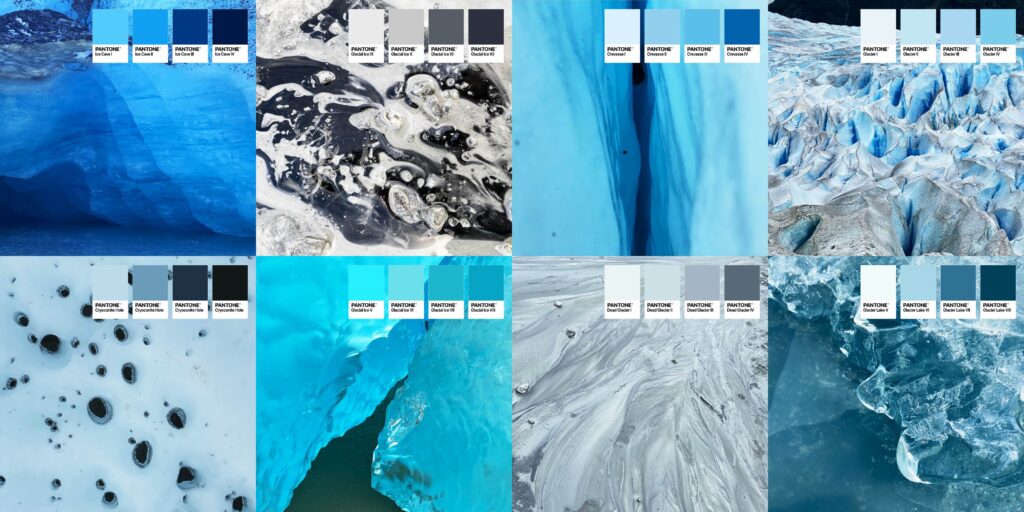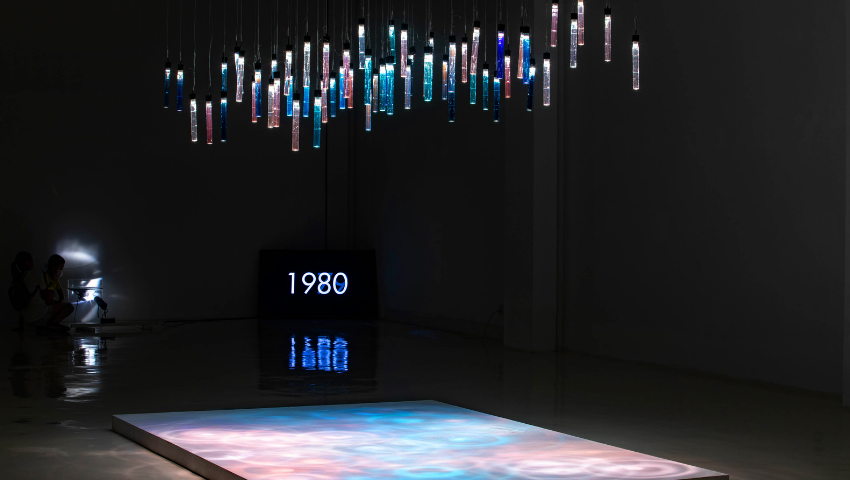© Jiabao Li
Glaciers are sentinels of climate change and the most visible evidence of global warming’s impact on the environment today. The SIGGRAPH 2022 Art Gallery selection “Glacier’s Lament” showcases the beauty, fragility, and magnificence of glaciers. We connected with Jiabao Li to learn more about the Alaskan glaciers that inspired this project and how it personifies climate change and the loss of glaciers.
SIGGRAPH: Share some background about your SIGGRAPH 2022 Art Gallery project “Glacier’s Lament.” What inspired the project?
Jiabao Li (JL): We traveled to a dozen glaciers in Alaska, the most northern state of [the U.S.] and our home state. With a small team of local artists, we summited a small mountain, which was once the glacier’s face, and gazed upon Matanuska Glacier in Juneau, Alaska. A mutual feeling swept over our group as we gazed upon the glacier’s face, retreating in the summer heat after two of the hottest summers on record. We realized two things that afternoon. Our children, were we to have any, would never see the glacier anywhere near the magnificence of today. Many alive today have no awareness that the choices we make are having a dramatic impact on our climate across world timescales, just outside human lifespans. Thus, we strove to make the intangible feeling of loss tangible, bringing the loss over geological timescales and the disappearing, ephemeral beauty to an embodied, tangible, accessible, and transportable form.
SIGGRAPH: How does “Glacier’s Lament” contribute to the larger climate change conversation?
JL: “Glacier’s Lament” attempts to express and meld the feeling of loss of ephemeral beauty of glaciers with the factual evidence of climate change. The goal is that in synthesizing these two realities — the factual and the perceived — the work can reach audiences beyond those directly impacted by the loss of glaciers before it is too late. At the same time, it is a love letter to an already diminished nature and mourning of that loss. “Glacier’s Lament” and “The Disappearing Blue” seek to make the impersonal data personal, and the personal experience of a changing environment heard. They recreate aesthetic dynamics of the loss of nature.
SIGGRAPH: Why is an art installation the right medium for your message?
JL: We see many graphs and charts about climate change. They are very distancing. An art installation and video turn the disembodied numbers and words into empathetic and tangible narratives to challenge the audience with the intricate beauty and irreversible change of nature.

SIGGRAPH: How did you develop “Glacier’s Lament”? What techniques did you use? Did you face any challenges?
JL: In “Glacier’s Lament,” we sought to represent the global scale of ice loss while touching upon the local feeling of loss of the artists who have lived near the glacier their entire lives. We took data of the polar ice sheet melting from 1959 to 2019 and wrote a program in Matlab to convert the data into sound waves, creating a duet. Every measure of the music is a year, and every note is a season’s data on cumulative ice loss. Summer months are thus high tones, with winter being the lowest tone in each measure. Two musicians from Juneau converted the sonified data from the software into sheet music and improvised a violin melody atop the computer-generated music, thus combining the personal experience of loss of a familiar face and beautiful natural phenomenon with the data of ice loss.
To further the personal narrative and add personification to the loss of glaciers, we enlisted a local Juneau dancer to co-choreograph and dance a piece inspired by the song. We enlisted Juneau videographers, glacier climbers, and enthusiasts to chart an expedition onto Mendenhall Glacier in summer 2020. Juneau has only a few sunny days in the summer months, so we needed to film “Glacier’s Lament” in a single Alaskan day (prolonged sunlight hours) atop the glacier.
We believe the identities of the creators of this piece matter. Their proximity to the subject in their livelihoods and lived experiences matters. As an Alaskan/global artist duo, along with several local artists, we brought both a hyper-local perspective with a sense of global impact — two scales that climate change hit.

In “The Disappearing Blue,” we photographed the many blues of the faces of Alaska’s glaciers, which are shed nightly (calving) with sickening cracking noises, cutting ever deeper until there is nothing left. We matched pigments with each blue color observed and filled recycled glass vials with the pigmented water from the melted glacier river. The vials were suspended 15–20 feet in the air with lighting selected and positioned such that the reflected light choreographed on the canvas beneath them in the gallery, much like the light on the mountainside off the face of the glacier.
We observed the glacier calving frequency at the Matanuska Glacier near Palmer, Alaska, and timed the release of one vial each time the glacier face calved. Each vial would fall on the giant white canvas beneath, never to refract light in its aqueous form again, but taking a new form just as the melted glacier would. As each vial falls, the exhibition becomes scarcer and scarcer of beautiful scattered light day by day. At the end of the exhibition, all 60 tubes fall, forming a painting on the canvas beneath.
SIGGRAPH: SIGGRAPH is excited to host its first in-person conference since 2019. What are you most looking forward to about the experience?
JL: I’m looking forward to seeing many friends and colleagues, both old and new, in person again! I also look forward to trying the demos and visiting the Immersive Pavilion and Art Gallery in person.
Experience “Glacier’s Lament” and other outstanding Art Gallery installations at SIGGRAPH 2022! Register now to attend in person in Vancouver, virtually, or in a hybrid capacity.
Jiabao Li creates works addressing climate change, interspecies world sharing, humane technology, and a just, sustainable future. Her mediums include wearable, robot, AR/VR, projection, performance, software, and installation. She is a current member of NEW INC Creative Science at the New Museum. In Li’s TED Talk, she uncovered how technology mediates the way we perceive reality. At Apple, she invented and explored new technologies for future products.
Li is the recipient of numerous awards, including iF Design Award, AACYF 30 Under 30, Falling Walls, National Endowment for the Arts, STARTS Prize, Fast Company World Changing Ideas Award, Core77, IDSA, A’ Design Award, and Webby Award. Her work has been exhibited internationally, at Ars Electronica, SIGGRAPH, Milan and Dubai Design Week, Shanghai Ming Contemporary Museum, ISEA, Anchorage Museum, OCAT Contemporary Art Terminal, CHI, Donghu Shan Art Museum, MOOD Museum of Design, and Alaska State Museum. Her work has been featured on Yahoo, TED, TechCrunch, Domus, CCTV, Yanko Design, Fast Company, Harvard Political Review, The National, Business Insider, Bloomberg, Leonardo, and South China Morning Post.
Li is an assistant professor at The University of Texas at Austin. Her lab explores the intersection of art, design, technology, and biology. The interests are broad spanning from interspecies co-creation to menstrual blood science. Li graduated from Harvard Graduate School of Design with a master of design in technology with distinction.












Leave a Reply